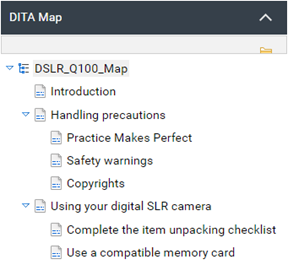Map an output structure
You can use a DITA map to organize a set of resources, such as topics, into a hierarchy. This feature is useful when producing structured content, such as XHTML, PDF, or Windows Help. In most output formats, the structure of the map becomes the structure of the table of contents. You can also use maps to define and resolve keys, references, and links. You can create and manage DITA maps using Inspire's Oxygen-based map editor. You can also create specialized types of DITA maps, such as a subject scheme or classification map.

![]() Before you start, read the Map Frequently Asked Questions (FAQs) to get answers to common issues.
Before you start, read the Map Frequently Asked Questions (FAQs) to get answers to common issues.